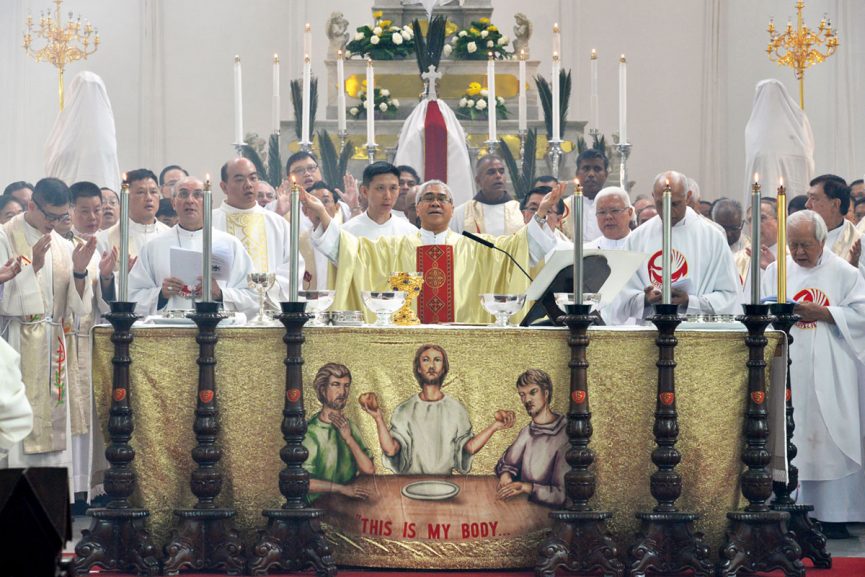No, we lay people should not be using the Orans Posture at Mass.
I noticed something last Sunday when I attended Mass. I noticed that many of my fellow brothers and sisters who were gathered at the Eucharistic Feast were opening their palms in prayer, especially during the various parts of the Eucharistic Prayer. As someone who has had the privilege of learning about the liturgy from a priest who holds a licentiate in Liturgical and Sacramental Theology, this caught my attention at once. I was not distressed about it, neither was I attempting to pass judgment on anybody, but I knew at once what I was going to write about this week.

I'm quite sure that what I am going to write today is going to unruffle the feathers of many. Like all my liturgical musings, I assure you dear reader, that I do not aim to offend or criticise anyone by means of this post. This musing is not an attempt to be a liturgical terrorist, or to push any agendas within the Church. I write this post with only one aim in mind; to shed some light on how the Church intends for her liturgies to be celebrated. And hopefully, this would aid all my readers in making sense of the Catholic Faith, and in their walk with God.

Why do priests pray using the Orans posture during various parts of the Liturgy? Simply put, he does so when he acts as the mediator of the prayers of the people. When a priest presides at Mass (or any of the Sacraments for that matter), he acts in Persona Christi, or in the person of Christ. When we celebrate the Liturgy, we are joining Christ in his prayer to the Father. Jesus Christ himself offers our prayers to his Father, and he does so on our behalf.
When the Mass begins, the Priest often walks down the aisle of the Church. What this symbolises is the Priest, who is acting in the person of Christ, collecting the prayers of the people, which he offers during various parts of the Mass, on their behalf. He does this during the Opening Prayer, which is also called the Collect, where he offers the prayers of the people which he collected at the start of Mass as he walked down the aisle. He also does this at the various parts of the Liturgy of the Eucharist, and throughout the Eucharistic Prayer, the prayer that Christ offers for his people. He does this at the Lord's Prayer, where we sum up all our prayers to the Father. The priest acts in the person of Christ, and he offers the prayers of the people, which he collected, to the Father on our behalf. That is why he uses the Orans Posture.
The GIRM is very clear that the Orans Posture is to be reserved for the priest alone. It is not for us, laity to use as we wish. In fact, the Liturgy is not a place for us to do as we wish as, it is the official public prayer of the Church. The priest uses this posture when he acts as the mediator of the prayers of the people. He was ordained for this. Even deacons do not use the Orans Posture at Mass. In fact, even the Priest may not use the Orans Posture whenever he feels like it. He only does so during the appropriate parts of the Liturgy.
We as laity do not have that responsibility or right to use the Orans Posture at Mass. Our role at Mass is to be active agents of participation in the mystery of Christ. We have a responsibility to join Mother Church in her highest form of worship, to approach the Eucharist with not only a great sense of personal devotion, but with an even bigger connection with the Body of Christ. And most importantly, we have a role (and in fact a responsibility) to allow the Eucharist to be a verb in our lives, not just a noun.
The sad reality is that many of us laity, and even some members of the clergy, see the rubrics of the Liturgy as merely a set of rules. And unfortunately, when Liturgists try to enforce the rules of the Liturgy, they are often seen by many lay people to be no better than the pharisees and sadducees. We need to move past this. As Catholics, we do not get to pick and choose when it comes to the teachings of the Church. While we may struggle to agree with some due to our human nature which God understands, we have to accept all of them nonetheless. We hold on to ONE Holy Catholic and Apostolic Faith. Jesus Christ himself has promised us that the gates of the underworld will never prevail against his Church.
Anything worth doing is worth doing well. When we celebrate the Liturgy, the highest form of prayer that Mother Church offers to God, it is worth doing it well; not just for the sake of following the rubrics, but to allow the Liturgy to transform us into disciples after the heart of Christ. Every rule is there for a reason. The Liturgy is not about us, or about praying in accordance to our own preferences. May we always remember this.

After the eucharistic prayer is concluded, the priest, with hands joined, says alone the introduction to the Lord’s Prayer, and then with hands extended, he pronounces the prayer together with the people (GIRM 152).
ReplyDeleteI think that many liturgists and articles agree with what you write above. However, my friend who is a priest consulted another liturgist that he knows. This liturgist said that while the GIRM has only prescribed the priest to raise (extend) hands, it does not prohibit the laity to do it.